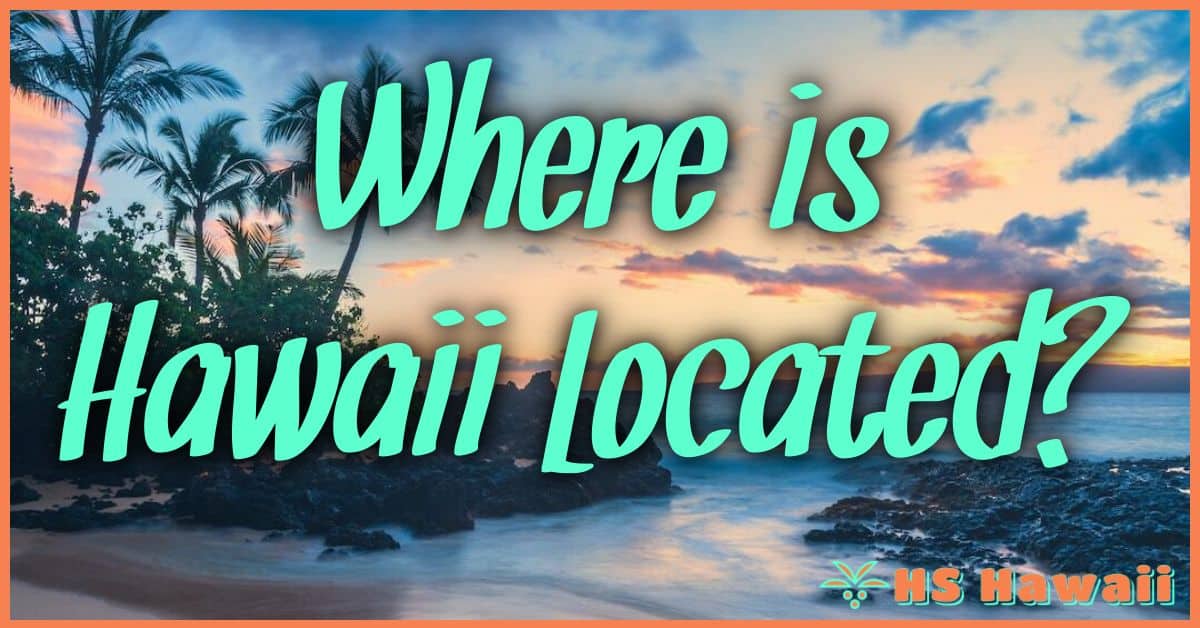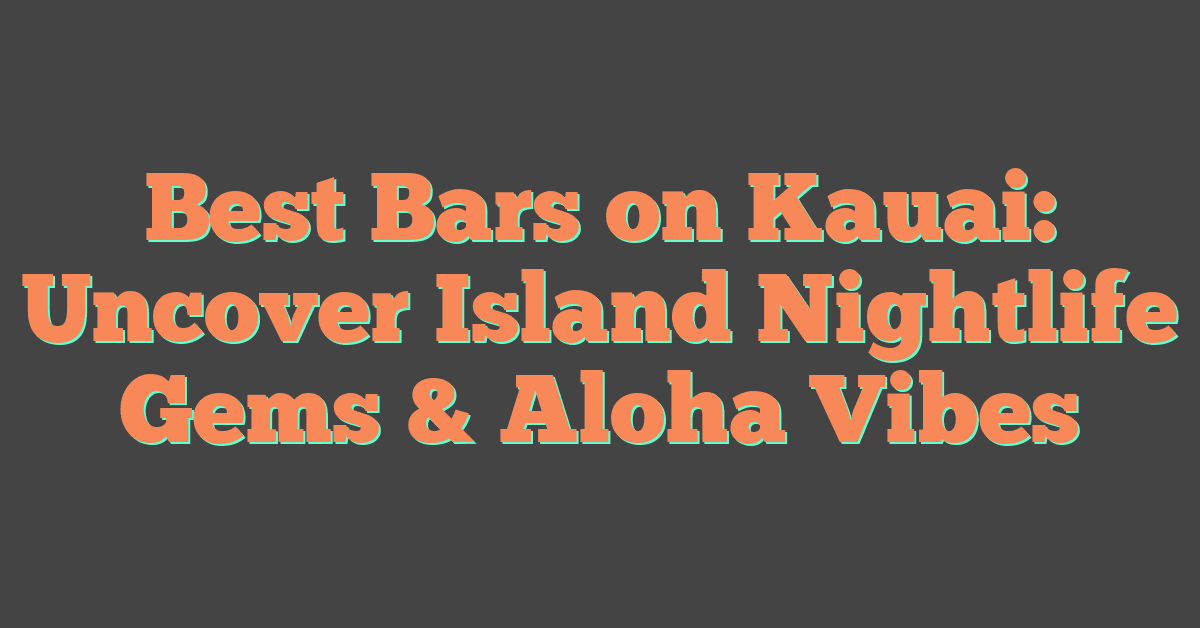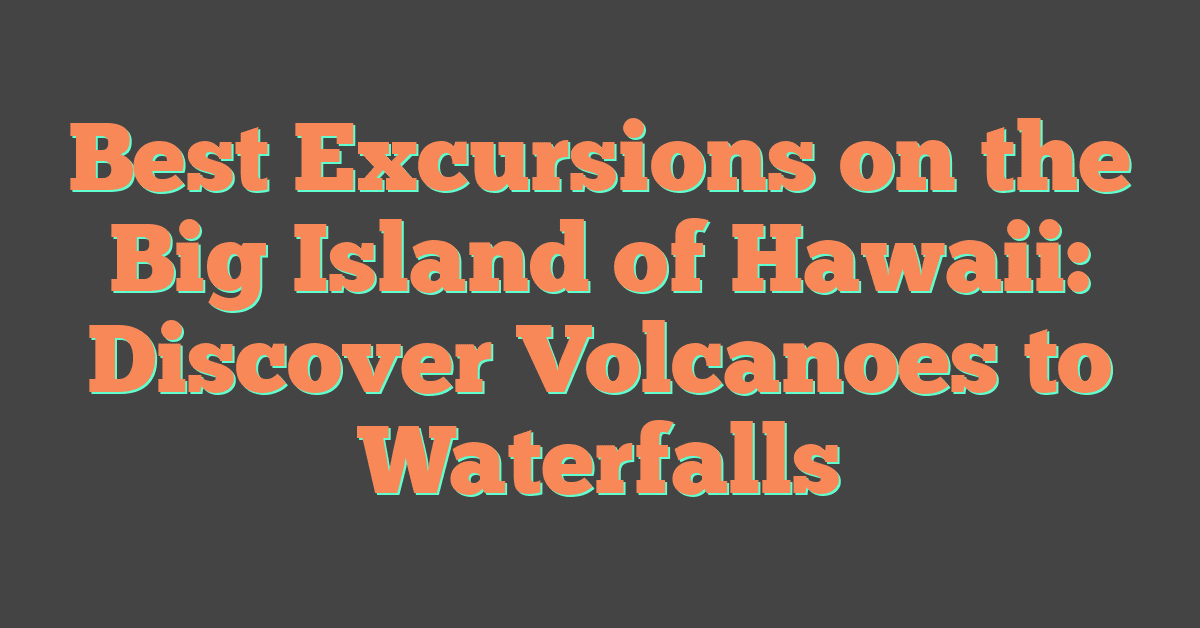Ever wondered where the tropical paradise of Hawaii is located? Well, you’re not alone. Nestled within the vast expanse of the Pacific Ocean, Hawaii lies far from any mainland, making it one of the most remote places on earth. It’s part of Oceania and is a state of the United States.

While you might associate Hawaii with beaches and palm trees, its location gives it a unique geographical identity that goes beyond this stereotype. Believe it or not, Hawaii sits approximately 2,400 miles southwest of California! This puts it closer to Asia than any other U.S. state.
The exact coordinates for Honolulu, Hawaii’s capital city are 21.3069° N latitude and 157.8583° W longitude. So if you’ve ever looked at a map and wondered exactly where in the world Hawaii is located – now you know! The isolation has contributed to the state’s unique biodiversity and cultural heritage which we’ll explore further in this article.
Unveiling Hawaii’s Geographic Placement
Ever wondered about Hawaii’s exact location on our planet? Let’s lift the veil on this tropical paradise. Nestled in the central Pacific Ocean, you’ll find Hawaii sitting pretty and waiting to be explored.
Your geography lessons might remind you that longitude and latitude are key in pinpointing a place. Well, Hawaii’s coordinates read as 21.3° N, 157.8° W. It means it’s located just below the Tropic of Cancer which explains its year-round warm climate.
It might surprise you that despite being a part of the United States, Hawaii is not situated on the North American continent! Instead, it holds its ground as an island chain far removed from mainland USA – nearly 2,400 miles southwest off California’s coast to be precise!
| Location Detail | Value |
|---|---|
| Longitude | 157.8° W |
| Latitude | 21.3° N |
| Distance from US Mainland (California) | ~2400 miles |
Next up: let’s size up these islands! The Hawaiian archipelago spreads across about 1,500 miles and contains hundreds of islands and atolls but only eight main ones – namely Hawaii Island (the Big Island), Maui, Oahu, Kauai, Lanai, Molokai, Kahoolawe and Niihau.
- The Big Island is aptly named with an area of over 4K square miles making it larger than all other Hawaiian Islands combined!
- Maui, also known as ‘The Valley Isle’, offers breathtaking landscapes.
- World-renowned Waikiki beach resides in Oahu.
- Renowned for its natural beauty is Kauai or ‘The Garden Isle’.
So there you have it! An intriguing blend of isolation yet connectivity defines Hawaii geographically – floating solo in the Pacific ocean yet firmly attached to one of the world’s superpowers – now isn’t that fascinating?
Hawaii in the Context of Pacific Islands
Ever wondered where is Hawaii located? You’re not alone. Nestled in the central Pacific Ocean, Hawaii’s geographical position has been a topic of interest for many globetrotters.
Hawaii serves as the northernmost island group in Polynesia, marking the northeast corner of what’s known as the Polynesian Triangle. This triangle also includes other well-known Pacific islands such as New Zealand to the southwest and Easter Island to the southeast.
When you look at it on a map, Hawaii seems like an isolated dot amidst vast oceanic expanses. But when you comprehend its location within this Polynesian Triangle—a region that covers over 10 million square miles—you begin to understand why Hawaii holds such strategic importance.
To give you some perspective:
| Distance from Hawaii | |
|---|---|
| Los Angeles | 2,471 miles |
| Japan | 3,850 miles |
| Australia | 5,673 miles |
These distances highlight just how remote Hawaii really is. Despite this seeming isolation, it’s strategically located between key global players: North America and Asia.
Hawaii consists of eight main islands:
- Hawai’i (the Big Island)
- Maui
- O’ahu
- Kaua’i
- Moloka’i
- Lānaʻi
- Ni’ihau
- Kaho’olawe
Each island boasts its own unique charm and natural wonders—from lush rainforests and towering volcanoes to sprawling beaches with sparkling blue waters.
In terms of climate, because it’s positioned near the equator line but still within tropics latitude range (between Tropic of Cancer and Tropic of Capricorn), you’re likely to experience tropical weather year-round with mild temperature fluctuations.
So there you have it—the scoop on where exactly in this wide world you’ll find Hawaii! No longer just an isolated dot on your map but a significant part of a larger context—the vast expanse of Pacific Islands nestled within the Polynesian Triangle.
Understanding
The Polynesian Triangle: Where Does Hawaii Fit?
Ever wondered where exactly Hawaii fits on the global map? Let’s dive into some geography. Hawaii is located in the Pacific Ocean, but more specifically, it’s nestled within a region called the Polynesian Triangle.
The Polynesian Triangle is an area in the Pacific Ocean with three vertexes – one at Hawaii, another at Easter Island and the third at New Zealand. This vast oceanic triangle hosts numerous islands that share cultural similarities due to historic migrations across these waters.
Here’s a quick overview of these vertices:
| Vertex | Location |
|---|---|
| Hawaii | Northernmost |
| Easter Island | Easternmost |
| New Zealand | Southernmost |
These locations collectively form what you’d call Polynesia. Among them, Hawaii plays a crucial role as it’s not only geographically significant but also culturally rich and diverse.
You see, Hawaii isn’t just one island; it’s an archipelago consisting of eight major islands and over 130 minor ones. Its location makes it unique because despite being part of the United States, it’s actually about 2,400 miles off California coast!
Let’s get down to specifics
- Latitude: Approximately 21 degrees North
- Longitude: Roughly 157 degrees West
This places Hawaii smack dab in the middle of the North Pacific Ocean! It’s no wonder this tropical paradise boasts such beautiful weather year-round – it sits comfortably within Earth’s tropic zone.
Can you imagine how important this positioning has been throughout history? It made Hawaii a vital port for ships traveling between Asia and America long before planes became dominant.
So now you know where to find Hawaii on your globe or world map. Indeed, knowing its place within the grander scheme of things – inside that immense Polynesian Triangle – offers fascinating insight into its cultural heritage as well as geographical uniqueness.
Latitude and Longitude: Pinpointing Hawaii on the Globe
If you’ve ever wondered exactly where Hawaii is located, it’s time to turn your attention to latitude and longitude. These geographical coordinates will help you pinpoint the exact location of this tropical paradise.
Hawaii sits comfortably in the Pacific Ocean, graced by a latitude of approximately 21.3 degrees North. This makes it situated just slightly south of the Tropic of Cancer. Its placement within these tropical latitudes means that you can expect warm temperatures year-round – perfect for beach lovers!
Let’s delve into its longitude next. Hawaii is nestled at about 157.8 degrees West. That puts it right smack dab in the middle of the Pacific Time Zone when considering standard geological divisions.
Here’s a visual representation:
| Latitude | Approximately 21.3° N |
| Longitude | Approximately 157.8° W |
Now that we’ve got those numbers down, let’s put them into perspective:
- Did you know? The state closest to Hawaii is California, which lies roughly 2,400 miles to its east.
- Fun Fact: Despite being an American state, Honolulu (the capital city) is actually closer to Tokyo than to Washington D.C!
In terms of global positioning, there really isn’t anywhere quite like Hawaii! From its tropical weather thanks to its latitude or its unique timezone due to longitude, every aspect adds depth to this splendid island destination.
Remember though; no amount of data can truly capture Hawaii’s allure – there’s so much more beyond these numerical coordinates! So why don’t we dig deeper into what makes this place truly enchanting in our next section? Stay tuned as we unveil more about this fascinating archipelago known as Hawaii!
Neighboring Bodies of Water Around Hawaii
Set like a gem in the vast Pacific Ocean, Hawaii’s geographical location provides it with several neighboring bodies of water. Let’s dive into this fascinating aspect of Hawaiian geography.
To start with, you’ve got the Pacific Ocean surrounding Hawaii on all sides. It’s important to note that the Pacific is the largest and deepest of Earth’s oceanic divisions. This massive body of water extends from the Arctic in the north to the Southern Ocean (or, depending on definition, to Antarctica) in the south.
Now let’s talk specifics about this region. The part of the Pacific that encircles Hawaii is often referred to as Central Pacific. This segment offers a unique blend of calm and turbulent waters due to its positioning between eastern and western currents.
If you’re wondering about more immediate neighbors, there are smaller sea areas around individual islands or clusters within Hawaiian archipelago itself. For instance:
- The Alenuihaha Channel separates Big Island (Hawaii) and Maui.
- Between Maui, Lanai, and Molokai lies Pailolo Channel.
- The strait separating Kauai from Oahu is known as Kauai Channel.
For your convenience, here’s a handy table summarizing these key points:
| Body Of Water | Location Relative To Hawaii |
|---|---|
| Pacific Ocean | Surrounding All Sides |
| Central Pacific | Specific Region Encircling |
| Alenuihaha Channel | Between Big Island & Maui |
| Pailolo Channel | Between Maui,Lanai,Molokai |
| Kauai Channel | Between Kauai & Oahu |
In conclusion: while we might think about Hawaii as an isolated island group in middle of nowhere – it’s actually immersed in a complex network of water bodies each playing their part in shaping both environment and culture for inhabitants over centuries!
Major Cities in Hawaii and Their Locations
You’re probably wondering, where exactly are the major cities located within the beautiful island chain of Hawaii? Let’s dive right into it.
First off, we have Honolulu, which serves as the capital city. It’s nestled on the southeastern coast of Oahu Island. Honolulu is not just a bustling city but also home to some stunning natural wonders like Diamond Head State Monument and Hanauma Bay Nature Preserve.
Next up is Hilo, situated on the Big Island’s eastern side. Hilo enjoys a rich history coupled with incredible landscapes such as Rainbow Falls and Liliuokalani Park and Gardens.
Over on Maui Island, you’ll find Kahului. As one of Hawaii’s largest census-designated places, it hosts an array of shopping centers and is considered to be Maui’s retail hub.
Lastly, don’t forget about Kailua-Kona located on the western coast of the Big Island. Known for its sunny weather and clear waters, this city offers historic sites like Puuhonua o Honaunau National Historical Park that will simply captivate your senses!
Here’s a quick rundown:
| City | Location |
|---|---|
| Honolulu | Southeastern Coast Oahu |
| Hilo | Eastern Side Big Island |
| Kahului | Maui Island |
| Kailua-Kona | Western Coast Big Island |
- Each city boasts its own unique charm
- All cities offer stunning views
- History buffs will appreciate each site’s historical significance
So there you have it! You’ve got a snapshot of where these major Hawaiian cities are situated within this tropical paradise. Keep these locations in mind when planning your visit – they’re sure to enrich any Hawaiian adventure!
How Time Zones Apply to Hawaiian Locale
When you’re planning a trip to Hawaii, it’s crucial to understand the time zone of this tropical paradise. Hawaii operates on Hawaii Standard Time (HST). It’s one of the last places on earth to experience the sunset each day due to its location in the Pacific Ocean.
Hawaii doesn’t observe Daylight Saving Time, so when it rolls around for most of us, they don’t change their clocks. That means from November through March, while your mainland friends spring forward or fall back an hour, you’ll have no such worries if you’re basking on a Hawaiian beach.
Let’s dive into more specifics:
| Months | Mainland US time zones difference |
|---|---|
| April – October | PDT: -2 hours; MST: -3 hours; CST: -4 hours; EST: -5 hours |
| November – March | PST: -2 hours; MST/CST/EST: all are 3-6 hours ahead |
Remember that these differences can affect communication with folks back home or any international calls you might need to make.
When comparing Hawaii’s time with global cities:
- Sydney is usually about 20 hours ahead.
- London typically leads by about 10 hours.
- Tokyo tends to be around 19 hours ahead.
It’s important not forget these facts when scheduling your activities and communications during your stay in Hawaii.
While adjusting your internal clock may take some time, remember that allowing yourself a day or two to acclimate will help ensure that you get the most out of your Hawaiian adventure. After all, who wants jet lag ruining their luau?
One unexpected perk? Being behind virtually everyone else in the world means sporting events start early in Hawaiian mornings! So grab a cup of Kona coffee and catch up with the latest games before heading out for a day at Waikiki Beach. Enjoy this unique aspect of being in beautiful Hawaii!
Climate Influence Due to Hawaii’s Location
Hawaii’s unique location in the world plays a key role in shaping its climate. Nestled comfortably within the tropics, it enjoys a cozy position just below the Tropic of Cancer. This position gifts Hawaii with a tropical climate that stays consistent year-round.
The constant flow of trade winds from the east also contributes to Hawaii’s pleasant weather. These prevailing winds bring cool breezes and frequent rain showers, making for lush landscapes and vibrant ecosystems across the islands. Despite this, you’ll find variations across different parts of each island due to terrain influences.
As you move inland on any Hawaiian island, you’ll notice an increase in elevation leading to cooler temperatures. Haleakala, on Maui or Mauna Kea on Big Island are examples where temperatures can drop below freezing during winter nights due to their high altitudes.
To give you more insights into how Hawaii’s latitude impacts its climate, take a look at this table:
| January (F) | July (F) | |
|---|---|---|
| Average High Temperature | 80 | 88 |
| Average Low Temperature | 66 | 74 |
These figures make it clear: there’s little temperature variation throughout the year in Hawaii due to its geographic positioning.
Yet another fascinating aspect is how volcanic activity influences local climates. Active volcanoes like Kilauea produce vog (volcanic smog), which can lead to hazy skies and even impact air quality on some days.
Here are some key points about how Hawaii’s location affects its climate:
- Its position near the Equator means minimal seasonal temperature variation.
- Trade winds from the east contribute towards cooler conditions and regular rainfall.
- Higher elevations have colder climates with possible sub-zero temperatures in winters.
- The presence of active volcanoes can affect local weather patterns and air quality.
In essence, understanding how these factors interplay gives us valuable insights into what makes up Hawaii’s unique climatic conditions.
Conclusion: Appreciating Hawaii’s Unique Position
The unique location of Hawaii sets it apart in the world. It’s situated in the central Pacific Ocean, far from any mainland or continent. This isolation has shaped its distinct culture, biodiversity, and stunning natural beauty that you’ll find nowhere else.
Let’s take a look at some key aspects:
- Geographical uniqueness: Hawaii is one of the most isolated places on earth. Its closest major landmass is California, over 2,400 miles away.
- Rich biodiversity: Because of its isolation, it’s home to species you won’t find anywhere else in the world.
- Vibrant culture: The influence of Polynesian ancestors remains strong in Hawaiian language, music and customs.
So when you think about where in the world is Hawaii located? Remember it’s not just about latitude and longitude. It’s about understanding how this unique position contributes to making Hawaii such a remarkable place.
In summary: Hawaii isn’t just another state—it’s an extraordinary location with a rich cultural history and unparalleled natural wonders. By appreciating its unique position, you can better understand what makes this island chain so special.
Remember that no matter where we are on Earth – whether it be bustling city centers or remote islands like Hawaii – geography plays an essential role shaping our communities and ecosystems alike. So let’s move beyond merely asking “where” something is located but also explore “why” it matters.
Take time to appreciate how beautifully diverse our planet really is—and remember that every location has its own unique story waiting for us to discover!




